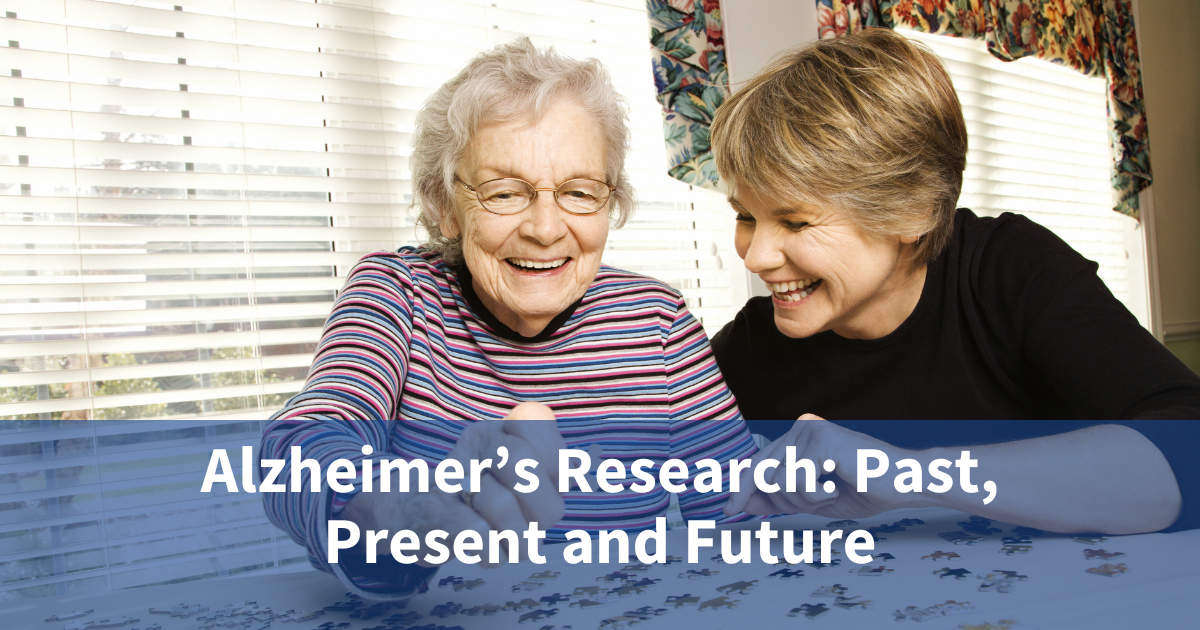Brought to you by:
“An ounce of prevention is worth a pound of cure.” – Benjamin Franklin
It’s easier to solve a problem if you know the cause. In medicine this means understanding why people get sick and treating the disease itself, not just the symptoms. For nearly 100 years, the medical community had limited knowledge about why people develop Alzheimer’s disease. Recent scientific discoveries are uncovering clues about what causes Alzheimer’s and how to stop symptoms before they start. To understand how far we’ve come, let’s look at a brief history of Alzheimer’s research.
Dr. Alzheimer Describes a “Peculiar Disease”
In 1906 a German psychiatrist named Alois Alzheimer presented the case of a “peculiar” disease at a conference. The patient, a woman in her early 50s known as “Auguste D.,” showed signs of memory loss, mood changes, paranoia and disorientation.1 After her death, Dr. Alzheimer studied sections of Auguste’s brain under a microscope and reported that her brain had shrunk in certain areas with abnormal “depositions.”1
For most of the twentieth century, researchers studied the clinical symptoms of Alzheimer’s and explored potential causes of the disease. As technology improved, experts began to use brain imaging, such as CT and MRI scans, to identify the microscopic plaques and tangles (what Dr. Alzheimer referred to as “depositions”) associated with Alzheimer’s disease.
Interested in supporting Alzheimer’s research? Learn more at TestforAlz.com.
The Search for a Diagnosis
In the mid-1980s the medical community created guidelines for diagnosing Alzheimer’s disease. At the time, experts believed that Alzheimer’s had only one stage, known as dementia, where patients showed clear signs of cognitive decline. Once someone showed evidence of Alzheimer’s dementia, they could receive treatments for their symptoms.
The 1980s guidelines assumed that only people with identifiable Alzheimer’s symptoms had the disease.2 Researchers later discovered that Alzheimer’s can start affecting the brain years before symptoms start, and that certain biological clues may indicate if someone is at risk of developing the disease.3
In 2011, experts revised the guidelines for diagnosing Alzheimer’s disease. New research showed that Alzheimer’s could lie dormant without symptoms for years, during a “silent” period known as “Preclinical Alzheimer’s Disease.”3 Experts were exploring ways to detect Preclinical Alzheimer’s by looking for early disease signs in cerebrospinal fluid, blood, and other sources.
2021 and Beyond – New Reasons to Hope
Researchers are currently investigating new ways to detect and treat Alzheimer’s in its early stages. The FDA recently approved the first drug designed to address the causes of Alzheimer’s disease.4 There are many more clinical trials in progress (the number of Alzheimer’s studies has doubled in the past ten years5) as well as increased funding for Alzheimer’s research from the US government and private donors.6 To learn more about Alzheimer’s research and how you can get involved, visit TestforAlz.com.
References
- Strassnig, M., & Ganguli, M. (2005, September). About a peculiar disease of the cerebral cortex: Alzheimer’s original Case revisited. Psychiatry (Edgmont (Pa. : Township)). Retrieved October 28, 2021, from https://www.ncbi.nlm.nih.gov/pmc/articles/PMC2993534/.
- Vaughn, P. (2011, April 19). Alzheimer’s diagnostic guidelines updated for first time in decades. National Institute on Aging. Retrieved December 3, 2021, from https://www.nia.nih.gov/news/alzheimers-diagnostic-guidelines-updated-first-time-decades.
- Sperling, R. A., Aisen, P. S., Beckett, L. A., Bennett, D. A., Craft, S., Fagan, A. M., Iwatsubo, T., Jack, C. R., Kaye, J., Montine, T. J., Park, D. C., Reiman, E. M., Rowe, C. C., Siemers, E., Stern, Y., Yaffe, K., Carrillo, M. C., Thies, B., Morrison-Bogorad, M., … Phelps, C. H. (2011, May). Toward defining the preclinical stages of alzheimer’s disease: Recommendations from the National Institute on Aging-Alzheimer’s Association workgroups on diagnostic guidelines for alzheimer’s disease. Alzheimer’s & dementia : the journal of the Alzheimer’s Association. Retrieved December 3, 2021, from https://www.ncbi.nlm.nih.gov/pmc/articles/PMC3220946/.
- FDA. (2021, June 7). FDA grants accelerated approval for Alzheimer’s drug. U.S. Food and Drug Administration. Retrieved December 6, 2021, from https://www.fda.gov/news-events/press-announcements/fda-grants-accelerated-approval-alzheimers-drug.
- A 2011 article from Alzheimer’s Research & Therapy reported 269 active Alzheimer’s trials worldwide. According to ClinicalTrials.gov, there were 638 active Alzheimer’s trials (defined as both recruiting and not yet recruiting studies) as of December 6, 2021, representing a 237% increase.
- When the Alzheimer’s Breakthrough Act was introduced in Congress in May 2011, the Alzheimer’s Association reported that the US government was spending $498 million per year on Alzheimer’s research. The Alzheimer’s Association expects the NIH to spend $3.2 billion on Alzheimer’s research in 2021 (a 643% increase since 2011).
- McKhann, G., Drachman, D., Folstein, M., Katzman, R., Price, D., & Stadlan, E. M. (1984, July 1). Clinical diagnosis of Alzheimer’s disease. Neurology. Retrieved December 3, 2021, from https://n.neurology.org/content/34/7/939.
- Vaughn, P. (2011, April 19). Alzheimer’s diagnostic guidelines updated for first time in decades. National Institute on Aging. Retrieved December 3, 2021, from https://www.nia.nih.gov/news/alzheimers-diagnostic-guidelines-updated-first-time-decades.
- McKhann, G. M., Knopman, D. S., Chertkow, H., Hyman, B. T., Jack, C. R., Kawas, C. H., Klunk, W. E., Koroshetz, W. J., Manly, J. J., Mayeux, R., Mohs, R. C., Morris, J. C., Rossor, M. N., Scheltens, P., Carrillo, M. C., Thies, B., Weintraub, S., & Phelps, C. H. (2011, May). The diagnosis of dementia due to Alzheimer’s disease: Recommendations from the National Institute on Aging-Alzheimer’s Association workgroups on diagnostic guidelines for Alzheimer’s disease. Alzheimer’s & dementia : the journal of the Alzheimer’s Association. Retrieved December 3, 2021, from https://www.ncbi.nlm.nih.gov/pmc/articles/PMC3312024/.



